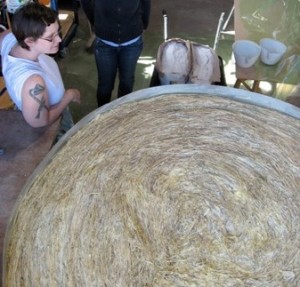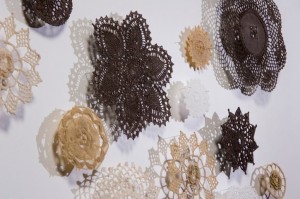I’ve known Elizabeth Perkins since she was about 16 years old, I think. In fact, I’ve always called her Beth.
I was Beth’s geometry teacher way back when. And I was so excited to find out that she’s now a very successful glass artist. After graduating from Atlanta College of Art in 1997 with a degree in sculpture, she embarked upon an amazing journey as an artist and teacher. She earned her MFA from Virginia Commonwealth University in 2004.
Like me, Beth grew up in a rural, southern town and has a very strong connection to her family, so I’m really moved by her work, which incorporates glass, found objects and heirlooms. But you know what I’m going to say next: The fact that Beth uses math in her art is both surprising and expected. Read on to learn more.
Can you explain what you do for a living? I work as a production glass blower for a company called Glassybaby and in addition serve as a contractual glass blowing and artist assistant to other professional artist here in Seattle. I also continue to make my own sculpture primarily in glass and am able to teach workshops in my specific area of expertise at Pratt Fine Arts Center.
When do you use basic math in your job? I use math all the time in my job. One of the primary areas is in creating and writing annealing programs. This is the process where glass is cooled slowly so that it can cool evenly from the outside to the inside. This differs depending on a glass’ annealing temperature, the thickness of the glass, size, and the thickness of the mold material (if you are casting glass). The annealing programs are structured on the Fibonacci sequence, an integer sequence.
Do you use any technology to help with this math? I usually do the math by hand, because I really have the need to visualize everything that I do. The math result (which is usually in diminishing time increments per hour) is then called the annealing program for your glass project, which for me as an artist changes with most every piece — because I rarely repeat any image. The annealing program is then put in to a controller. The controller works on a relay to turn on and turn off the electricity in the heating elements inside an annealer or kiln. Some controllers are set up to combine the time per hour cumulatively and some are not. So I sometimes adjust the type of program based on the controller I am using. All of my mold materials, as well as glass, are measured when creating castings, so that the ratios are correct. This insures that the “investment” (mold body) is as strong as it can be, to hold up to temperatures up to 1600 degrees. Measuring the glass is also important so that the mold is completely filled but not overfilled. (If a mold overflows, that can ruin the kiln.)
How do you think math helps you do your job better? Without math, I would be very wasteful with time and resources. Math helps to create little science experiments in my daily artistic practice, as well as a strong control for testing firings and materials to get the best outcome in my work. When I am working on a project, I keep detailed notes of all of my recipes for investment bodies and glass and the temperature that each glass moves. Because all glasses and all colors of glass have a different material composition and they move at different rates and temperatures. The firing and annealing schedules also are included variables in these experiments. These are all the things I deal with on a daily bases that have everything and nothing to do with the image I am trying to convey in glass. Every sculpture includes created and solved math problems.
How comfortable with math do you feel? I have always, well, just not been very strong in math. I use it everyday though. I am one of those people that feels comfortable with patterns and shapes. So perhaps I am more comfortable managing things like the Fibonacci sequence as well as geometry in my art practice problems. I find now that my measuring has come so routine that I can feel the investment body when it is wet and know if the ratios are right and kind of fudge it with smaller sculptures. With larger sculptures I can’t take those shortcuts. I often use the old woodworker’s rule of measuring twice and cutting once. I always check and re-check my math.
What kind of math did you take in high school? I took the required math but no advanced math courses. I liked geometry, but I never felt like I was ever good at math or liked it. But I think for this reason I have a deep satisfaction when I am able to figure out these strange solutions to artistic problems. I once became obsessed with figuring out the physics involved in the weight differential of glass on the end of a glass pipe. (Glass pipes have a standard length but the material amount varies depending on what you are making, and it is constantly changing form while you are making it.)
Did you have to learn new skills in order to do the math you use in your job? Yes. I had to build on very basic math skill sets, only because I was unable to comprehend much of math. I do think because math is necessary for what i do I am even more motivated and eager to find solutions.
I am a skilled, talented, and a creative artist, I feel very good about that and very proud. I feel very honored that the math teachers I had in high school somehow managed to create “a current between the wires.” But I guess even a pickle can carry current. I use lots of math on a daily basis, and without their lessons I would not be able to make my work at all. While math is not my lover, it’s certainly a confidant. It’s always got my back.
And without Beth, I may not have felt like a great teacher. Have questions for Beth? Feel free to ask them in the comments section.
All month, we’ll be talking about art and talking to artists. So stay tuned — and fall in love with the math of art.


